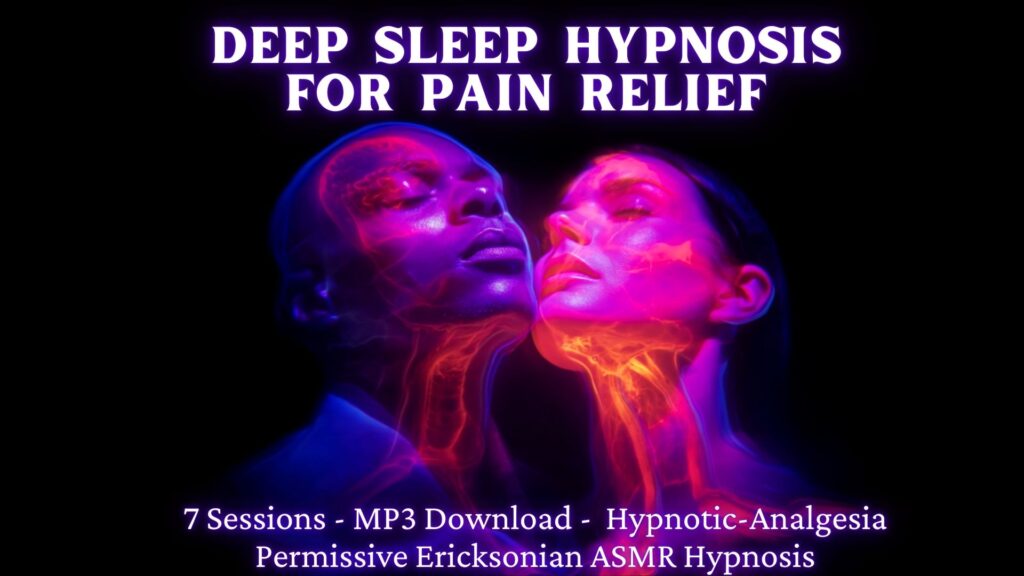
A Mind-Body Approach to Rewiring the Brain
Pain is not just a physical experience. It’s deeply personal, emotional, and psychological. one, shaped by how the brain interprets signals from the body.
In fact, neuroscience now confirms what ancient healing traditions and modern hypnotherapy have long suggested: pain is created in the brain, and that means it can be changed by the brain. By allowing yourself to be guided into a deeply relaxed state, self-hypnosis can alter neural processing of pain so that discomfort can be perceived as less intense.
⚠️ Important: Self-hypnosis is a Complementary Intervention and not intended to substitute medical treatment. Always consult your healthcare provider for persistent or severe pain and only underlying health issues.
What Is Hypnotic Analgesia & How Can Sleep Hypnosis Help with Pain?
Hypnotic analgesia is the scientific term for pain relief achieved through the use of hypnosis. When we become deeply relaxed, the brain enters a calm, trance-like state— (non-sleep deep rest) where the conscious mind, or “thinking mind” quiets, and the subconscious becomes more open to suggestion. It’s here that targeted imagery and language can help influence and rewire the brain’s pain response pathways, leading to an experience of reduced discomfort, better sleep, and a deeper sense of control.
Studies show that up to 70% of people with chronic pain experience immediate relief during hypnosis, and many report sustained improvement with repeated use. Functional MRI scans even show changes in pain-processing regions of the brain—like the thalamus, anterior cingulate cortex, and somatosensory areas—after hypnotic suggestion.
- Pain is Modulated by the Brain. Signals from injured tissue must activate a network of brain areas (the so-called “pain matrix”) including the insula, ACC, thalamus and somatosensory cortices. Only when these regions light up do we actually experience pain.
- Engaging the Subconscious mind. In hypnosis, you enter a trance-like state of focused attention and awareness. This state quiets the usual “thinking” mind and makes suggestions easier to accept. Hypnotic suggestions thus bypass resistance and can reshape how you feel and respond to discomfort.
- ASMR-style audio amplifies relaxation. My sessions use ASMR-inspired elements (soft whispering, gentle ambient sounds, solfeggio frequencies), enhancing the experience of relaxation as much as possible. Research and anecdotes alike show ASMR can temporarily reduce stress, improve mood, and even ease chronic pain.
If you’re curious, feel free to explore the program or try one of the free sleep hypnosis sessions on my YouTube channel. Wherever you are in your journey, know this: you are not broken—and there is hope. Your body and mind are more adaptable than you may have been led to believe.
Pain Program Guide – Click here to download the Guide for this Hypnosis Program for Pain Relief!
For instance, while you drift toward sleep, the soothing guidance of a male or female- voiced hypnosis might invite your subconscious to “imagine a warm wave of comfort spreading through your body” or “feel your muscles relax as tension melts away.” These suggestions can induce any of the following:
- Reduce pain intensity. Suggestions like “your pain is becoming less and less” directly encourage the brain to tone down pain signals and sensations.
- Increase comfort or numbness. Imagery may turn discomfort into another sensation (e.g. a numb or tingling feeling), effectively diverting the pain.
- Shift attention away. Gentle cues might guide you to focus on soothing images or breath, which naturally distracts (also known as dissociation) the brain from pain.
- Increase hope and confidence. Suggestions can reinforce self-efficacy, for example “you are safe and in control; your body knows how to heal,” which can reduce the stress and emotionally related components of chronic pain.
Clinical reviews find that hypnosis with pain-specific suggestions consistently outperforms non-treatment controls in reducing pain severity, duration, and frequency. Indeed, hypnosis has been shown to be at least as effective as other active treatments (relaxation, biofeedback) and more effective than standard care in trials. In our programs, every session is carefully scripted to include research-backed analgesia cues, metaphors, and powerful suggestive imagery to maximize these benefits.
Understanding the 4 A’s of Pain Coping

Pain psychology expert Bruce N. Eimer identified a set of four core strategies that people can use to influence their pain experience. These strategies are not just coping “tricks. They represent distinct ways the brain can reorganize its relationship with pain.
- Avoidance: Redirecting Your Attention
Pain naturally grabs our attention. But when we give it all our focus, it tends to intensify. Avoidance techniques teach you how to shift your attention in safe and intentional ways using imagery, breath work, and soothing sounds to guide the mind elsewhere.
You might focus on a relaxing mental image, like ocean waves or a warm bath. In a hypnotic state, these visualizations become immersive, helping the nervous system regulate and rebalance. It’s not about ignoring the pain, it’s about teaching the brain that there are other signals worth paying attention to.
- Alteration: Changing How Pain Feels
Alteration strategies help reframe or re-sensitize pain itself. For example, pain may be reimagined as warmth, tingling, or pressure (less threatening sensations that are easier for the body to tolerate). Through guided imagery, you might visualize the pain “melting away” or drifting out of the body like smoke.
This is where the mind’s imagination becomes medicine. When you change the way your brain interprets pain, you often change the way you experience it. And remember, what the mind can create, the body can feel.
- Alleviation: Turning the Volume Down
Direct alleviation techniques work through hypnotic analgesia—which is the process of reducing pain signals by calming the brain’s pain center activity. One classic exercise is using the metaphor of the “pain dial.” You can imagine gently turning down a pain dial that controls your experience of pain, and intentionally allow a sensation of numbness or comfort to flow in.
While this might sound abstract, brain imaging studies show that hypnosis can actually lower activity in pain-related brain regions, leading to a measurable drop in pain intensity. The body begins to relax, and the mind begins to believe: “Maybe I can feel a little better, even if its temporary”.
- Awareness: Observing Pain Without Fear
The last A is often the most surprising. Instead of escaping pain, awareness strategies invite you to become curious about it. By observing pain as a neutral sensation—without judgment or panic—you create space between yourself and the discomfort.
This approach is especially helpful for reducing the emotional suffering that often accompanies pain, like fear, dread, or hopelessness. Through awareness, you can learn to say, “I notice this sensation, but I don’t have to fear it.” And in that space, the pain often softens on its own. In our Deep Sleep Hypnosis for Pain Relief program, clients are invited to self-reflect and monitor the sensations they are experiencing in not only their bodies but that as well of the psyche.
The Emotional Layers of Chronic Pain

Beneath the surface of sore muscles, stiff joints, or burning nerves lies a deeper landscape—emotions, beliefs, and past experiences stored in the body. Pain often arises or intensifies during times of unresolved stress, trauma, or grief. Even after the original cause fades, the emotional imprint can linger, quietly reinforcing tension and resistance in the nervous system.
Deep Sleep Hypnosis offers a safe and effective way to gently explore these hidden layers. When you’re in a trance-like state, the thinking mind relaxes, and the subconscious becomes more receptive to suggestions for healing.
You may begin to notice that your pain first flared during a season of emotional overwhelm…Or that it worsens when you feel trapped, unsupported, or unheard.
You might uncover a belief like, “I can’t trust my body” or “I’ll never feel normal again.”
These beliefs are not flaws—they are protective patterns. And when met with understanding and gentle reframing, they can begin to loosen their grip.
Rewiring Emotional Patterns With Hypnosis
Below is a chart of common emotional and cognitive patterns linked to chronic or acute pain, alongside a reframed emotional tone and thought that hypnosis can help anchor into the subconscious.
| Negative Emotion | Common Thought | Positive Emotion (Reframe) | Empowering Thought |
| Fear | “This pain means something is seriously wrong.” | Reassurance | “My body is safe in this moment. Healing is happening now.” |
| Anxiety | “What if this never gets better?” | Trust | “I’m learning new ways to support my healing every day.” |
| Helplessness | “There’s nothing I can do to stop this.” | Empowerment | “I can influence how I feel through breath, focus, and rest.” |
| Guilt | “Maybe I caused this. It’s my fault.” | Self-forgiveness | “I did the best I could. I deserve compassion, not blame.” |
| Grief | “I miss how things used to be.” | Acceptance | “I can honor my past while creating new pathways forward.” |
| Shame | “Others must think I’m weak or faking it.” | Self-respect | “My experience is valid. I don’t have to prove my pain.” |
| Anger | “Why is this happening to me?” | Understanding | “My body is asking for care, not punishment.” |
| Frustration | “Nothing ever works. I’ve tried everything.” | Hope | “Each moment is a new chance to try something different.” |
| Isolation | “No one understands what I’m going through.” | Connection | “Others have walked this path too. I am not alone.” |
| Despair | “This pain has taken over my life.” | Possibility | “Relief is possible. My body and mind are capable of change.” |
By gently allowing positive suggestion to reframe negative ones during a hypnosis session, (especially in that quiet state just before falling sleep), the brain can begin to build new emotional circuits. Over time, the nervous system can learn a different pattern: one that is softer, safer, and more receptive to healing.
This is the heart of my Deep Sleep Hypnosis Program for Pain: offering your subconscious mind the chance to rewrite old stories, soften emotional and physical tension, while welcoming in relief.
A Holistic Approach to Pain Relief
What I’ve seen over and over again, both personally and professionally, is this: when we include the subconscious mind in our healing, something interesting happens. Muscles release. Breath deepens. Pain loses its edge. We begin to relate to our bodies differently, not with fear or frustration, but with kindness.
Below is detailed look at how each session in the program is designed to support your healing and recovery:
🔹 Track 1: Foundational Session – Mental Rewiring & Subconscious Priming
This opening session gently introduces your mind to the science and psychology of pain perception—explaining how the brain interprets pain and how the subconscious plays a vital role in regulating it. It reframes pain as a neuroplastic and modifiable experience, planting empowering suggestions that your mind can begin to shift how it processes discomfort. This track creates a fertile foundation for the work that follows, combining psychoeducation with early hypnotic induction to prime your inner landscape for change.
🔹 Track 2: The 4 A’s – Autogenic Training for Mind–Body Control
This track guides you through the Four A’s of Pain Management—Avoidance, Alteration, Alleviation, and Awareness. These core principles, adapted from pain psychology, are taught through soothing hypnotic language and autogenic training techniques (where the body learns to respond to mental and verbal cues). You’ll learn how to shift your attention, transform the way pain feels, reduce its intensity, and observe it mindfully—training your body to follow your inner guidance with increasing ease.
🔹 Track 3: Rapid Pain Relief – Anchoring the Power Phrase: “Switch Off Now”
Using a more direct, assertive tone (while still remaining gentle), this session helps condition your subconscious to associate the phrase “Switch off now” with relief and release. Through repetition and embedded commands, your mind begins to anchor this phrase as a trigger for comfort. This track is ideal for moments of acute discomfort when you want to calm your system quickly and instill a sense of control.
🔹 Track 4: Inner Healing & Emotional Release – The Pain Beneath the Pain
Pain doesn’t just live in the body—it often carries emotional residue like grief, shame, identity confusion, or stored exhaustion. This deeper session explores the emotional and existential dimensions of chronic pain, weaving in truisms, self-forgiveness, and gentle spiritual reconnection. Think of it as a heart-opening experience that allows old wounds to surface, be witnessed, and soften through compassionate inner dialogue.
🔹 Track 5: Hypnotic Analgesia – The Healing Liquid Goo Visualization
This richly immersive session uses sensory-heavy metaphor and ASMR-style voicework to guide you through a dreamy visualization involving a healing, magical substance—like warm, golden goo—that flows into your body, melting pain and tension away. It’s a hypnotic analgesia experience designed to engage your imagination fully, soothing both the body and the subconscious with every drop.
🔹 Track 6: Subliminal Suggestions & Conversational Hypnosis
Layered beneath soothing tones and ambient frequencies, this track delivers affirmations and “afformations” (questions that bypass mental resistance, like “Why is my body healing so well?”). Embedded within are solfeggio frequencies and conversational hypnosis patterns, allowing you to passively absorb positive beliefs while you sleep or rest. It’s perfect for deep subconscious integration without conscious effort.
🔹 Track 7: Self-Reflection – Emotional Debrief and Gentle Insight
This final track offers space for inward inquiry. It can be used actively (as a self-assessment) or passively (as an emotional debrief) to help you check in with yourself: What’s softened? What’s still holding on? What’s changed since I started? Gentle prompts and reflective questions help you track your emotional and physical shifts throughout the program—an ideal way to build self-trust and observe your growth.
Who This Program Is For
This program was created for people who are ready to work with their pain in a new way. It’s for those who are open to exploring their inner world—who want to blend science and soul, and who are curious about what becomes possible when the mind and body begin to work together.
You may resonate with this program if:
- You’re managing chronic pain or frequent acute pain
- You want non-pharmaceutical, complementary tools to support your existing treatment
- You’re curious about hypnosis, ASMR, or guided sleep meditation
- You sense that your pain may carry emotional weight or subconscious patterns
- You enjoy altered states, deep relaxation, or spiritual self-healing
- You’re interested in resetting your nervous system and deepening body awareness
- You’ve tried everything else—and want to find anything that can work!
Begin Your Healing Journey
You don’t have to struggle alone—or stay stuck in the same pain response. When the brain is calm, and the subconscious is supported, change becomes not just possible… but natural.
🎧 Explore the full Deep Sleep Hypnosis for Pain Relief program here
🎥 Or listen to a preview track on Hypnotic Intentions YouTube
References:
● Barber, J. (1996). Hypnosis and suggestion in the treatment of pain. W. W. Norton & Company.
● Himmelblau Gat, C., et al. (2025). Personal Danger Signals Reprocessing: New online group intervention for chronic pain. arXiv preprint.
● Rossi, E. L., & Cheek, D. B. (1988). Mind-body therapy: Methods of ideodynamic healing in hypnosis. W. W. Norton & Company.
● Spiegel, H., & Spiegel, D. (1987). Trance and treatment: Clinical uses of hypnosis. American Psychiatric Press.
● Syrjala, K. L., & Abrams, J. R. (1996). Hypnosis and imagery in the treatment of pain. In R. J.
● Watkins, J. G., & Watkins, H. H. (1997). Ego states: Theory and therapy. W. W. Norton & Company.
● Zeidan, F., Adler-Neal, A. L., Wells, R. E., & Coghill, R. C. (2024). Mindfulness meditation-based pain relief employs different neural mechanisms than placebo and sham mindfulness meditation-induced analgesia. Biological Psychiatry, 95(6), 478–488.

